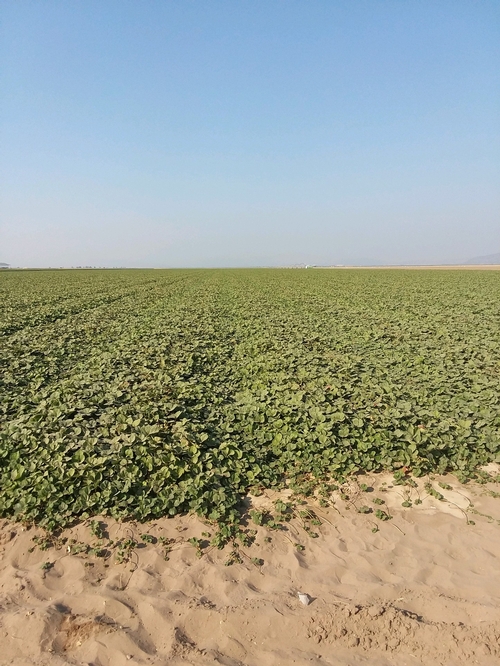High Temperatures in Plant Nurseries - Some Thoughts
I've been entertaining a fair number of calls from worried growers, farm managers and others in regards to the warmer than normal temperatures this year at the strawberry plant nurseries up in Northern California. Plants will be delayed in entering dormancy in this environment and might not be setting up well (see photo 1 below from October 6; thank you Doug Thomas). The concern is what this is going to translate to in the production fields here on the Central Coast.
For those unfamiliar with the concept of cold conditioning, aka chill, recall that strawberries and caneberries are plants from temperate regions, and rely on enough accumulation of time in certain cold ranges during the winter, most often 28 to 45o F, to develop and produce fruit normally the following season. The field portion of cold conditioning for strawberry concerns itself with entering dormancy, which manifests itself as you would expect with coloring of the leaves and cessation of growth. Not entering into this stage and or having this in insufficiency in strawberry generally results in lower vigor and productivity later on.
Yes, the amount of chill hours for strawberries this year are pretty low in comparison with most others, with the implication that growers will be faced with lowered fruit productivity because of it. At last view on October 15, 2020 in Macdoel, CA, where most of our plants are grown, we had accumulated 267 hours of cold between the critical temperatures of 33-45 o F, where in the previous two years it was already above 300 hours by this date. Then again, looking back to 2017, the chill hours accumulated in this range by October 15 was 257, and most people will say that the fruit production that year was good. However, the catch this year is the abnormal amount of hot weather during the day, which according to several chill accumulation models subtracts from that accumulated at the colder end. Bottom line is that it looks like we are lacking in field cold accumulation this year in comparison to past years.
Obviously to the extent possible, growers should seek to get harvest dates by which time sufficient field chill has been accumulated. However, while delay might be a tactic for a few days, growers need to be aware that prime planting is the first two weeks of November for UC varieties, and pushing out from that just to get higher amounts of chill might not work out so well. Additionally, nurseries aren't necessarily going to delay harvest since it runs the risk of getting into wet weather and the subsequent impossibility of harvesting plants at all.
So what does a grower do to accommodate this situation of low field chill? The supplemental chill, which is the cold storage of the transplants postharvest, can't substitute for the chill accumulated in the field and should not be adjusted one way or the other from that recommended by UC or proprietary breeder guidelines. From the UC side at least, those guidelines come from many years of research, and do represent the optimum storage length across a variety of years and subsequently environmental conditions. The plant at the stage of supplemental chill is not in the same state as it was in the field with all of its leaves, roots in soil and exposed to the daily cycle of light and dark.
I can only underline that close adherence to good planting practices, again available in many places such as the UC IPM guidelines and other sources on California strawberry, will grant benefit to the plant and overcome some of the dearth of vigor we expect from less than normal field chill. Good soil preparation, planting roots straight down rather than J rooting, delaying bed plastic placement, keeping plants moist at all times until planting and afterward with abundant irrigation will enhance plant productivity whatever the case has been in the nurseries.
Let's not be cutting any corners this year folks lest the endeavor end in tears is my thought right now.

A grass green field of Monterey in Macdoel, California, October 6, 2020. Total amount of chill hours between 33 and 45 degrees, 168. Photo courtesy Doug Thomas, Crown Nursery

